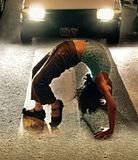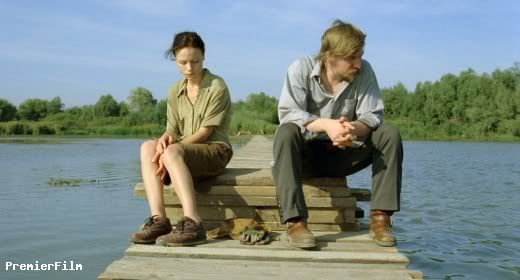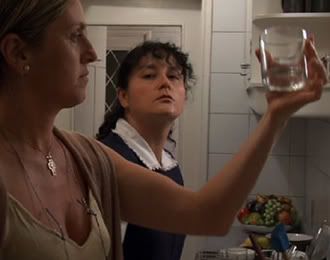-
Down there I sell whiskey and cards. All you can buy up these stairs is a bullet in the head.
Vienna (Joan Crawford) in Nicholas Ray’s Johnny Guitar

BULLET IN THE HEAD (Spain)
When someone says that a movie is boring, to me that means that she didn't find enough in the film to keep her interested. In other words, boredom is in the mind of the beholder. There are exceptions. Warhol's 5-hour Sleep and his 8-hour Empire are well…boring. For most of it’s 85-minute duration, Bullet in the Head is boring. In the pre-credits sequence, a guy puts in motion an impossibly elaborate contraption that culminates with a gun firing a bullet into his head. One wonders if writer/director Jaime Rosales has dispensed with the expectation raised by the title of his third feature. The scene is designed to make us wonder whether or not the remainder of the film will include another act of violence. Bullet in the Head is boring because only the ambient sounds are audible, not the dialogues. It's also boring because, for over an hour, we observe a portly middle-aged guy engage in normal, quotidian activities. At the park, for instance, he talks with a woman and plays with a little boy. We never find out if she is his wife, or sister, or friend. When he initiates sex inside a woman’s apartment or engages another guy in conversation at a bar, all the context that dialogue could provide is absent. The rhythm of the editing, the typical placement of the camera behind windows and physical barriers and far from the subject, and signs and ads suggesting a geographical location somewhere near the border between Spain and France create some interest. Not enough interest, until the final 15 minutes, when the camera gets closer to our anonymous protagonist and his two associates at a restaurant. Using a classic shot/reverse shot sequence, Rosales changes the visual strategy to create an ominous mood. The looks exchanged between the trio sitting at a table and two men sitting on stools at the counter announce that something significant is about to happen.
Bullet in the Head is inspired by the December 2007 killing of two unarmed Civil guards on surveillance duty by members of the Basque separatist group ETA. But this is ultimately of no consequence. What Rosales conveys with tremendous authority and deep conviction is that there is no valid excuse, no valid cause, no valid explanation and nothing to understand about such an event. The psychological profile and political ideology of the killer(s) is irrelevant. You or me can perpetrate an act of violence and find a way to rationalize it. It would be wrong no matter what trauma we experienced in our childhood and no matter how strongly we believe violence is a necessary means to further our political viewpoint. To give the viewer clues as to who this killer is and what he stands for by means of characterization, dialogue and plot would be counter to film's unwavering moral position. Rosales refuses to use violence as a means of entertainment and diversion. He delivers a deeply resonant, rigorous anti-thriller.
There are many films that have an effect on us only while the projector is running and then dissipate from our consciousness. Bullet in the Head is that rare film that is perhaps boring throughout most of its duration but has the potential to inform our lives and remain indelibly etched on our minds long after we've left the theater.
-

OBLIVION (Peru)
Dutch-Peruvian director Heddy Honigmann has fashioned a homage to the ability of the poor and working class people of Lima to survive and sometimes thrive despite being neglected and forgotten by often corrupt politicians. Sympathetic portraits of craftsmen, people in the service industry and street performers are punctuated by brief archival footage of presidential inaugurations and empty political rhetoric. Segment about a disabled woman and her little kids, who earn a living by doing pirouettes at a busy intersection is particularly moving, especially after you learn one of the woman’s kids died after being hit by a car. Honigman’s voice is often heard conducting interviews but she’s not seen and doesn’t offer any opinions. She lets her subjects and her editing do that. PBS should pick Oblivion up for broadcasting within its Frontline or Independent Lens series. Oblivion furthers Honigmann's legacy of depicting proletarian Peruvians. It fits perfectly as a companion to her award-winning Metal y Melancolia, a documentary about the struggle of Lima's taxi drivers during the country's late-90s economic crisis. Variety's Jay Weissberg praises the director's "usual expert eye full of wryly expressed quiet outrage". Oblivion has won awards at documentary film festivals worldwide.
-

DELTA (Hungary)
Delta won the '08 Hungarian Film Week then it was a competition selection at Cannes, a coup for writer/director Kornel Mundruczo (Johanna, an operatic adaptation of Dreyer's The Passion of Joan of Arc). Delta won the Fipresci Prize at Cannes, beating films by such prestigious directors as Garrel, Martel, Eastwood, Wenders, Zhang-Ke, Soderbergh and the Dardenne brothers. Delta credits Hungarian master Bela Tarr as "script consultant" which makes sense in view of the film's miserablist sensibility.
Delta concerns the return of a young man to his hometown, a small village near a bucolic stretch of the Danube. Mihail is treated as an outsider by most; his bartending mother seems more worried than happy to see him. His decision to refurbish an old hut near the delta, a distance from the village, appears wise. His half-sister Fauna follows him, shortly after a long-shot scene shows her being raped by her mother's boyfriend. They build a thin but sturdy pier and become settled. The townspeople are highly disapproving of their living arrangement. Actually, the relationship between Mihail and Fauna does acquire incestuous overtones. The unsuspecting couple invite everyone to a housewarming party and pay the consequences.
Delta boasts excellent cinematography, particularly apparent when it alternates between paradisiacal and ominous views of the landscape. The characters are individuated only to the extent that they register as archetypes, with Fauna and Mihail as innocent-naturals, attempting to lead a life of self-sufficiency and freedom from moral constraints, and the town's denizens as ugly victims of their isolation from culture and civilization. Delta depicts small-town life as a dystopia, as a place where man's baser instincts are likely to emerge and take hold. The film's expressionistic use of sound, the music score by Felix Lajko, and strategically incorporated bits of Schubert make a strong contribution to the overall experience. The short running time (96 minutes) makes Delta an ideal test-case for those who have yet to sample Tarr's much longer displays of that specifically Hungarian brand of poetic gloom.
-



PRINCE OF BROADWAY (USA)
There ought to be an exhibition circuit for this distributor-less Amerindie, a winner of Best Film at the Los Angeles fest that received very good reviews from important industry magazines Variety and The Hollywood Reporter. Like co-writer/director Sean Baker's last film Take Out, Prince of Broadway's protagonist is an undocumented immigrant pursuing happiness, or at least peace of mind, in the less conspicuous corners of Manhattan. This time his name is Lucky and he hails from Africa. Lucky makes a living by inducing customers into the hidden backroom of a tiny clothing shop where knockoffs are sold. The store is owned by a friendly 40ish Armenian American going through marital problems. The two men get along fine and so far have managed to avoid getting busted. Prince of Broadway's key twist involves Lucky's ex-girlfriend, a carefree Latina who dumps her toddler in Lucky's modest room and claims Lucky is the father. She doesn't sound trustworthy when she says she'll return in two weeks.
Prince of Broadway doesn't have the visual sophistication and psychological nuance of the films of Roman Bahrani, another Amerindie director with the same neorealist sensibilities as Baker. But Prince of Broadway is a consistently engaging, entertaining and authentic slice-of-life that deserves to be seen despite the occasional rough spot.
-

THE MAID (Chile)
As part of my coverage of the 2005 MIFF, I reviewed Live-In Maid, after it received the Special Jury prize at Sundance a month earlier. That film, featuring a phenomenal performance by Norma Aleandro, became one of those rare South American films that manage to get distribution in this country. This year I watched The Maid, written and directed by Sebastian Silva, fresh off Sundance '09 wins as both Grand Jury Prize (best film) and Special Jury Prize (Catalina Saavedra, for best performance).
Saavedra is Raquel, a frumpy woman in her 40s who has worked for the Valdes family for 23 years. The Spanish title La Nana specifies that Raquel is not any maid, but the type who gets directly involved in the raising of the children. To some extent, she is part of the family. For instance, there is a generational conflict with mother figure/daughter overtones between Raquel and first-born Camila, a college student. On the other hand, Raquel still takes her meals alone in the kitchen. The Maid however, focuses on what happens when the very sympathetic Mrs. Valdes decides that Raquel's recent health problems are caused by overwork and hires a second maid. Raquel perceives this as a threat and an affront and proceeds to make life unbearable to a series of women hired to assist her. That is, until Mrs. Valdes finds a candidate able to deal with whatever Raquel dishes out and see beyond her severe surface.
I love the way this film manages to be a psychologically nuanced portrait of Raquel without ignoring certain socioeconomic aspects endemic to relations between employers and servants. I admire Silva for allowing us to enjoy the humor in the situation while respecting the need to remain grounded in reality. And, while the whole ensemble is fine, I love the way Catalina Saavedra makes me believe every single step on the way to her transformation.
The Maid has just begun its run through the festival circuit, but I'm convinced it will eventually open in commercial screens at major American cities.
-


INVOLUNTARY (Sweden)
Scenes from five stories alternate in this second feature by director/co-writer Ruben Ostlund. The narratives of the stories are not related to each other although they're connected by a concern for the behavior of individuals in group situations. A respectable middle-aged host downplays the severity of an eye injury as to not to spoil the party he's giving. A bus driver refuses to resume a trip until someone confesses to breaking a bathroom fixture. A schoolteacher conducts a class experiment on peer pressure and then must defy her colleagues' silence about an abusive teacher. One of two blonde teens gets into trouble at the end of a day of drinking and partying. A group of men in their late 20s reunite for a nature hike but one of them is no longer receptive to their teenage sexual pranks.
The performances are naturalistic and probably not entirely scripted. On the other hand, the framing of the scenes is mannered and distinctive, which I found amusing but purposeless. There is little indication as to how Ostlund feels or what he thinks about this five vignettes. I personally only managed to remain somewhat interested in their resolutions. To my surprise, Involuntary has had a good reception in the festival circuit, particularly but not exclusively in its native Sweden.
-

THE HANDLESS TRICK (Spain)
Cuajo ("tadpole"), a rapper, and his best friend Adolfo struggle to realize their dream of owning their own recording studio. They sell stolen goods to raise money to buy equipment. When merchandise doesn't move fast and payments can't be made, they're at the mercy of impatient thugs. This premise is fairly familiar and could be set in the ghettos of any major city. Movies about guys from the skids having to do risky and illegal things to fulfill dreams of legitimate success abound. What perked my interest in The Handless Trick is that it's set in Barcelona, Cuajo has cerebral palsy and Adolfo is black. This is a Spanish equivalent of the French "banlieu" films that depict multiracial communities from the least desirable suburbs of big cities.
When The Handless Trick reveals what makes this particular ethnic stew unique and when its main concern is characterization, it soars. The most memorable scenes involve Cuajo's daily wrestling with the limitations imposed by his disability and Adolfo's exchanges with his alcoholic, homebound, immigrant father. The film becomes much less interesting when it aims to further a narrative with overly familiar elements. Use of real locations, the performance by disabled hip-hop artist El Langi in the lead role, and the eclectic, percusive music score contribute greatly to the film's attractiveness. The Handless Trick won the Spanish Academy Award for Best Debut Film for director Santiago Zannou at the '09 Goyas.
Last edited by oscar jubis; 03-22-2009 at 10:46 AM.
 Posting Permissions
Posting Permissions
- You may not post new threads
- You may not post replies
- You may not post attachments
- You may not edit your posts
-
Forum Rules





 Reply With Quote
Reply With Quote









Bookmarks